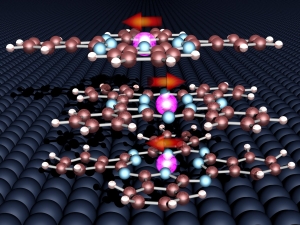“This special interaction between organic molecules and metal surfaces could help to manufacture information storage systems in a more simple, flexible and cheaper way,” explains Wulf Wulfhekel from KIT. Microscopic magnets with constant orientation are used in hard disks, for example. With a view to “printable electronics”, organic molecules indeed could open up new simple production methods utilizing the self-organization of molecules.
In the present study, three molecular layers of the dye phtalocynine were applied to the surface of ferromagnetic cobalt. Whereas the magnetic moments of the molecules alternatingly align relative to the cobalt and relative to each other, the molecules form a so-called antiferromagnetic arrangement. The magnetic orientation of this combination of antiferromagnetic and ferromagnetic materials remains relatively stable even in the presence of external magnetic fields or cooling. “Surprisingly, the “lightweight” molecule wins this magnetic arm wrestling with the “heavyweight” ferromagnetic material and determines the respective properties,” Wulfhekel says. Systems of antiferromagnetic and ferromagnetic materials, among others, are used in hard disk reading heads. So far, manufacturing of antiferromagnets has been quite complex and time-consuming. Should molecules be suitable for use in the production, the antiferromagnets one day will simply come out of the printer.
The present publication is the result of a cooperation of researchers from KIT, University of Strasbourg, and Synchrotron SOLEIL. First author Manuel Gruber was member of the German-French Graduate School “Hybrid Organic- Inorganic Nanostructures and Molecular Electronics”, where different aspects of nanoelectronics, spintronics, and organic electronics are investigated.
In close partnership with society, KIT develops solutions for urgent challenges – from climate change, energy transition and sustainable use of natural resources to artificial intelligence, sovereignty and an aging population. As The University in the Helmholtz Association, KIT unites scientific excellence from insight to application-driven research under one roof – and is thus in a unique position to drive this transformation. As a University of Excellence, KIT offers its more than 10,000 employees and 22,800 students outstanding opportunities to shape a sustainable and resilient future. KIT – Science for Impact.

